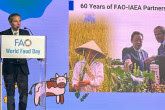World Food Day 2024: IAEA DG Highlights Joint IAEA And FAO Atoms4Food Initiative To Reduce Global Hunger

By Monika Shifotoka, IAEA Office of Public Information and Communication
This World Food Day highlights how everyone, everywhere, should have access to varied, nutritious, affordable, safe and sustainable food under the theme “right to foods for a better life and a better future.”
Speaking on World Food Day at the opening session of the FAO Science and Innovation Forum in Rome, Mr. Rafael Mariano Grossi, marked World Food Day together with Director-General of the Food and Agriculture Organization (FAO) of the United Nations Qu Dongyu. The Forum took as its theme “Good food for all, for today and tomorrow”. The Director General highlighted the IAEA and FAO’s long-standing partnership and the importance of their joint Atoms4Food initiative.
Millions go to bed hungry every night. Since 2020, food insecurity has more than doubled. Climate change is causing more crop failures.
We need to grow more food—and do it better.
My #WorldFoodDay piece explores how @IAEAorg/@FAO #Atoms4Food is helping: https://t.co/uct6lpx5jo pic.twitter.com/CnQTY7RrEL
— Rafael MarianoGrossi (@rafaelmgrossi) October 16, 2024
“There was a need to gather our efforts, to work in an efficient and very concrete way hence the launch of the Atoms4Food initiative. With the Atoms4Food initiative, we are able to assist Member States in their efforts in areas from soil and water management to pest control,” said Grossi. “Our responsibility goes beyond policy—it’s to deal with the problem. Addressing the problems that science reveals is paramount. For over 60 years, the IAEA and FAO have been at the forefront of turning knowledge into action.”
This year, the IAEA and FAO celebrates the 60th anniversary of its Joint FAO/IAEA Centre of Nuclear Techniques in Food and Agriculture. The Joint Centre supports countries in building capacity to apply nuclear and related techniques that help to cultivate stronger, healthier and more nutritious crops as well as build sustainable food systems that are resilient to climate change.
Addressing participants at the same event, Dongyu, emphasized the collaboration and partnership between the two agencies.
“Only these two organizations in the UN system, FAO and IAEA have enjoyed more than 60 years of physical collaboration. We have done this through the Seibersdorf laboratories.”
The IAEA, in collaboration with the Food and Agriculture Organization of the United Nations (FAO), works with scientists around the world to increase crop yields, boost biodiversity with new varieties and enhance climate smart agriculture, helping farmers use soil, water and nutrient resources more efficiently and sustainably. They also help ensure that food is safe to eat, boosting exports and helping reduce food loss.
This #WorldFoodDay, I am calling on all of us to renew our commitment to building more efficient, more inclusive, more resilient & more sustainable agrifood systems that produce enough, diverse foods, while preserving biodiversity & protecting the planet. #4Betters #RightToFood pic.twitter.com/Fw0j8u6ccQ
— FAO Director-General QU Dongyu (@FAODG) October 16, 2024
For example, through climate-smart agriculture, scientists in Kenya are using nuclear science to help farmers improve their planting practices and use water resources more sustainably amid changing climate patterns, bolstering food security in the country.
New crop varieties such as mung beans and chickpeas that can withstand periods of drought, saline soils or invasive pests are being developed by the IAEA through a process called mutation breeding . This is when irradiation is used to accelerate the natural evolution of plants to create adapted varieties with improved traits. Since its first use in 1964 it helped create more than 3400 crop varieties around the world.
The Joint FAO/IAEA Centre sent seeds to the International Space Station in 2022 to explore the effects of cosmic radiation and microgravity on plant genetics. Scientists are now analysing the space-induced mutations to identify the specific traits it generated and compare it with these induced in laboratories. Techniques such as food irradiation, a gentle and non-invasive technology that preserves the nutritional content, flavour and overall quality of food products, exemplify nuclear science’s role in food safety.
Another way to reduce food loss is the environmentally friendly sterile insect technique (SIT). Each year, up to 40 per cent of global crop production is lost to plant pests and diseases. In Senegal, SIT has been employed to successfully control tsetse flies in the Niayes Region.
The IAEA also provides countries with the equipment and training necessary to use nuclear techniques to tackle malnutrition.
The Joint Centre cooperates with more than 400 research institutions and laboratories to support countries by providing the necessary expertise, training, and equipment.
The work of the IAEA also extends to enhancing food safety, by applying nuclear techniques to detect possible contaminants.
Growing Food Security through the Atoms4Food Initiative
The IAEA and FAO launched a flagship Atoms4Food Initiative last year to expand the use of innovative nuclear techniques through the 7 services to enhance agricultural productivity, reduce food losses, ensure food safety, improve nutrition, and adapt to the challenges of climate change.
** Professors Simon Johnson, also of MIT, and James Robinson are of the University of Chicago.







